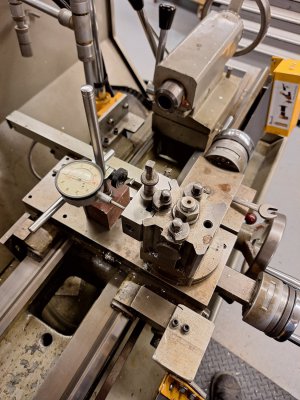- Joined
- May 3, 2020
- Messages
- 369
I'm facing 4140 bars to length and getting some chatter. It seems to depend on the angle of the tool. When the load is mainly radial, I get chatter. When the load is split between radial and axial, no chatter. Does this indicate that my bearings need more pre-load?
I'm using TPMT-321 tools, the McMaster budget set. As I face across a 2-5/8" bar, if I use a tool that presents the tip of the triangle, raking 45-degrees in the direction of the cut, no chatter. That is, the load is split, half radial (along the tool path) and half axial (into the headstock). I can take a 0.020 cut at 600 RPM, hand feed, with no problems. As the insert dulls, I can feel the increased pressure but still no chatter.
If I use the same insert but the cutting edge is parallel to the axis of the part, I get a lot of relatively high pitch chatter. I recognize the sound from other cuts. I can feel it in the sheet metal around the headstock but not in the carriage. In this mode, the cutting force is perpendicular to the axis of rotation.
When I run at 600 RPM, the bearings warm up after several hours but it is not alarming. If I run at 1000 RPM, the bearings heat up much faster but it's still not too bad. Under 130 oF, I think, because I can hold my hand on the headstock near the bearings. I recently cleaned and lubricated the bearings with Isoflex NPU 15. I adjusted pre-load until axial play was under a 10th with a load of about 20 lbf. I did not fiddle around with it very much. The previous owner of this 9x20 lathe upgraded the bearings with roller bearings. The grease had dried out a but but the bearings looked good so I re-used them, with a good amount of expensive grease worked into them.
I'm open to any advice or suggestions regarding interpretation, tooling, inserts, greasing, bearing pre-load, etc.
I'm using TPMT-321 tools, the McMaster budget set. As I face across a 2-5/8" bar, if I use a tool that presents the tip of the triangle, raking 45-degrees in the direction of the cut, no chatter. That is, the load is split, half radial (along the tool path) and half axial (into the headstock). I can take a 0.020 cut at 600 RPM, hand feed, with no problems. As the insert dulls, I can feel the increased pressure but still no chatter.
If I use the same insert but the cutting edge is parallel to the axis of the part, I get a lot of relatively high pitch chatter. I recognize the sound from other cuts. I can feel it in the sheet metal around the headstock but not in the carriage. In this mode, the cutting force is perpendicular to the axis of rotation.
When I run at 600 RPM, the bearings warm up after several hours but it is not alarming. If I run at 1000 RPM, the bearings heat up much faster but it's still not too bad. Under 130 oF, I think, because I can hold my hand on the headstock near the bearings. I recently cleaned and lubricated the bearings with Isoflex NPU 15. I adjusted pre-load until axial play was under a 10th with a load of about 20 lbf. I did not fiddle around with it very much. The previous owner of this 9x20 lathe upgraded the bearings with roller bearings. The grease had dried out a but but the bearings looked good so I re-used them, with a good amount of expensive grease worked into them.
I'm open to any advice or suggestions regarding interpretation, tooling, inserts, greasing, bearing pre-load, etc.




